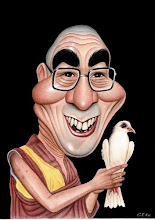

Enroute to Spiti Valley I spent a week in Old Manali (2000m above sea level).....a little village in Kullu Valley. The Kullu Valley is popular with Indian honeymooners, hippies and adrenaline junkies. The honeymooners come here for the cool climate and almost Swiss-like scenery; the hippies for the charas (marijuana) and the adrenaline junkies for the huge range of adventure sports on offer here (ballooning, rafting, para gliding, mountaineering, rock climbing, mountain biking, skiing and trekking). Old Manali (but not the fast growing New Manali) still retains some of the feel of an Indian mountain village with some beautiful old houses made  of wood and stones. Most foreign travelers stay in Old Manali leaving New Manali to the masses of local Indian tourists. In Old Manali the
of wood and stones. Most foreign travelers stay in Old Manali leaving New Manali to the masses of local Indian tourists. In Old Manali the  first question guesthouse workers ask is ‘Do you smoke?’ Being new to this area I thought that this is being asked with regards to the allocation of smoking and non-smoking accommodation but subsequently I realized that question was really a subtle approach to the pushing of charas. In Old Manali the smoking of charas is done publicly without any reservation - even some restaurants provide you with chillums for this purpose!!!!!
first question guesthouse workers ask is ‘Do you smoke?’ Being new to this area I thought that this is being asked with regards to the allocation of smoking and non-smoking accommodation but subsequently I realized that question was really a subtle approach to the pushing of charas. In Old Manali the smoking of charas is done publicly without any reservation - even some restaurants provide you with chillums for this purpose!!!!!
I thought Upper Dharamsala is picturesque but here in Old Manali the mountain vistas are just gorgeous. Now I understand why my friend Stanley once mentioned that many Europeans come and spend a few months here annually to enjoy the lush green hills with a backdrop of snowcapped mountain peaks and the very pleasant cool climate (between April and October). Decent accommodation is cheap and plentiful plus there is quite a wide range of good food (and decent coffee) to sample. And with the easy availability of charas no wonder this used to be (and still is) a paradise for hippies/travelers. Instead of stopping here for a couple of days as planned I ended up spending a week not because I have developed an attachment to charas but rather because Rohtang La, the high mountain pass (4000m) to the Spiti Valley was closed to traffic for almost a week owing to heavy rain and landslides. While I had a very relaxing week in Old Manali area I also had one of the most exhilirating days of my trip so far. - free wheeling down the mountain roads on a mountain bike! Was dropped off up at Rohtang La (4000m) and had the ride of a lifetime all the way down to Manali (2000m) through stunning mountainous landscapes. A most memorable ride!





































































